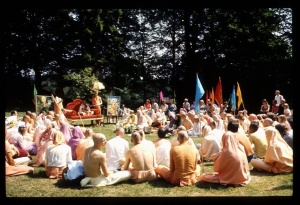BG 15.2 (1972): Difference between revisions
No edit summary |
(No difference)
|
Latest revision as of 08:41, 14 December 2017

A.C. Bhaktivedanta Swami Prabhupada
TEXT 2
- अधश्चोर्ध्वं प्रसृतास्तस्य शाखा
- गुणप्रवृद्धा विषयप्रवालाः ।
- अधश्च मूलान्यनुसन्ततानि
- कर्मानुबन्धीनि मनुष्यलोके ॥२॥
- adhaś cordhvaṁ prasṛtās tasya śākhā
- guṇa-pravṛddhā viṣaya-pravālāḥ
- adhaś ca mūlāny anusantatāni
- karmānubandhīni manuṣya-loke
SYNONYMS
adhaḥ—downward; ca—and; ūrdhvam—upward; prasṛtāḥ—extended; tasya—its; śākhāḥ—branches; guṇa—modes of material nature; pravṛddhāḥ—developed; viṣaya—sense objects; pravālāḥ—twigs; adhaḥ—downward; ca—and; mūlāni—roots; anusantatāni—extended; karma—according to work; anubandhīni—bound; manuṣya-loke—in the world of human society.
TRANSLATION
The branches of this tree extend downward and upward, nourished by the three modes of material nature. The twigs are the objects of the senses. This tree also has roots going down, and these are bound to the fruitive actions of human society.
PURPORT
The description of the banyan tree is further explained here. Its branches are spread in all directions. In the lower parts, there are variegated manifestations of living entities, such as human beings, animals, horses, cows, dogs, cats, etc. These are situated on the lower parts of the branches, whereas on the upper parts are higher forms of living entities: the demigods, Gandharvas (fairies), and many other higher species of life. As a tree is nourished by water, so this tree is nourished by the three modes of material nature. Sometimes we find that a tract of land is barren for want of sufficient water, and sometimes a tract is very green; similarly, where the modes of material nature are proportionately greater in quantity, the different species of life are manifested in that proportion.
The twigs of the tree are considered to be the sense objects. By development of the different modes of nature, we develop different senses, and, by the senses, we enjoy different varieties of sense objects. The source of the senses—the ears, the nose, eyes, etc.-is considered to be the upper twigs, tuned to the enjoyment of different sense objects. The leaves are sound, form, touch—the sense objects. The roots, which are subsidiary, are the by-products of different varieties of suffering and sense enjoyment. Thus we develop attachment and aversion. The tendencies toward piety and impiety are considered to be the secondary roots, spreading in all directions. The real root is from Brahmaloka, and the other roots are in the human planetary systems. After one enjoys the results of virtuous activities in the upper planetary systems, he comes down to this earth and renews his karma or fruitive activities for promotion. This planet of human beings is considered the field of activities.